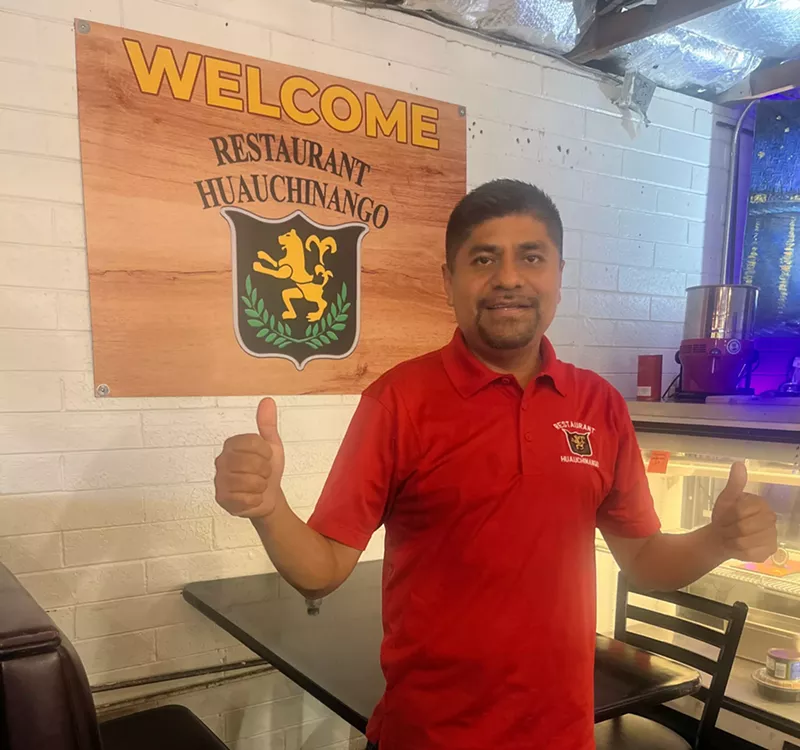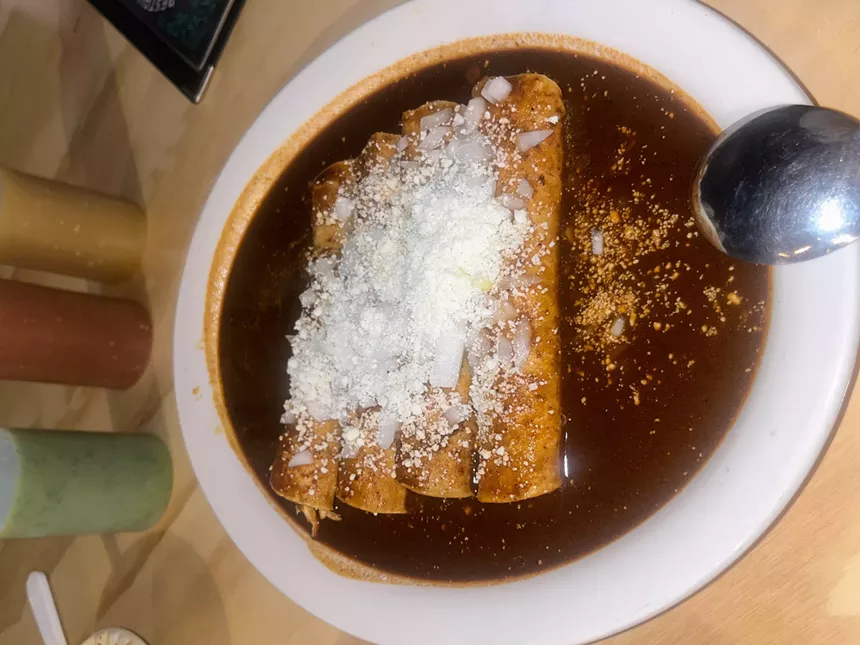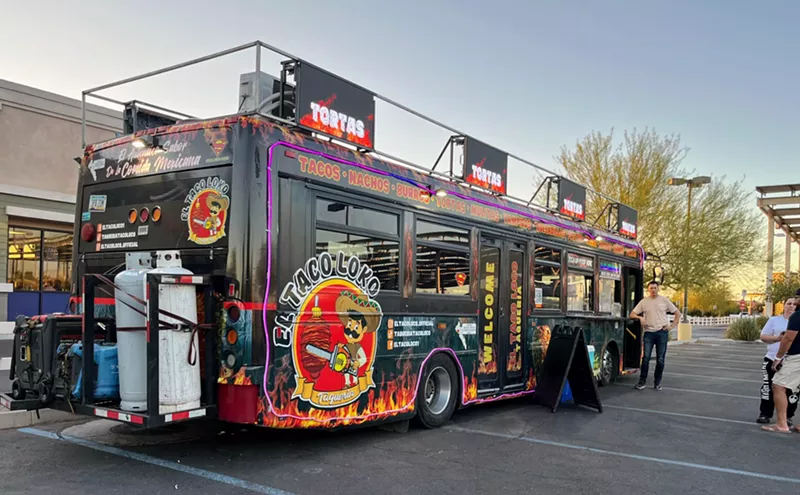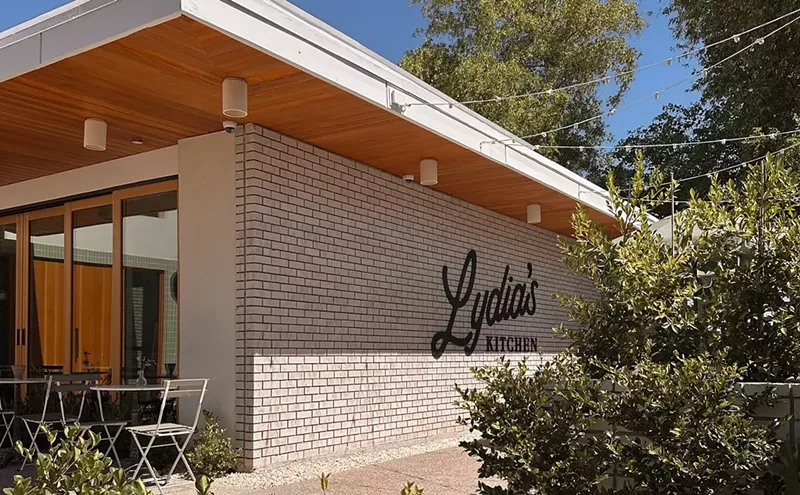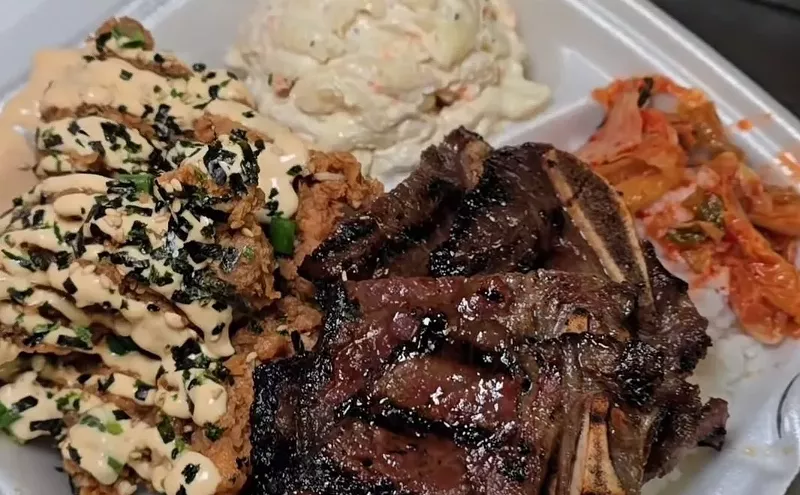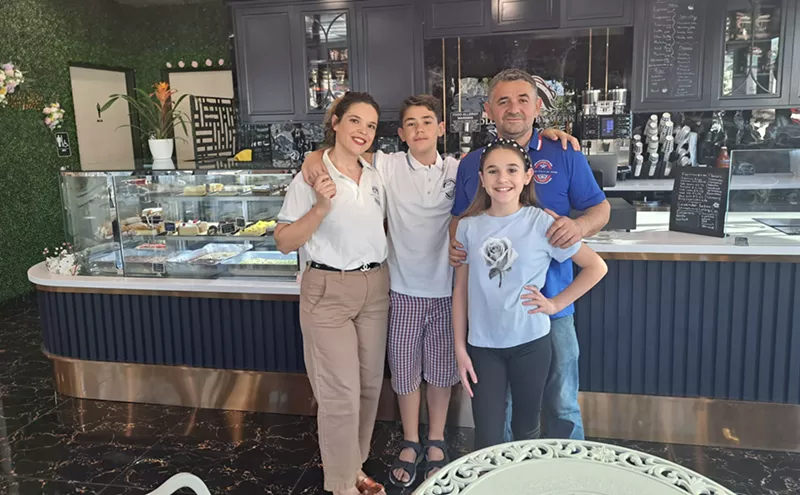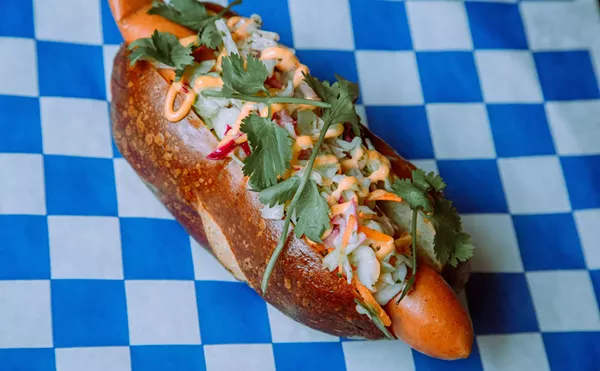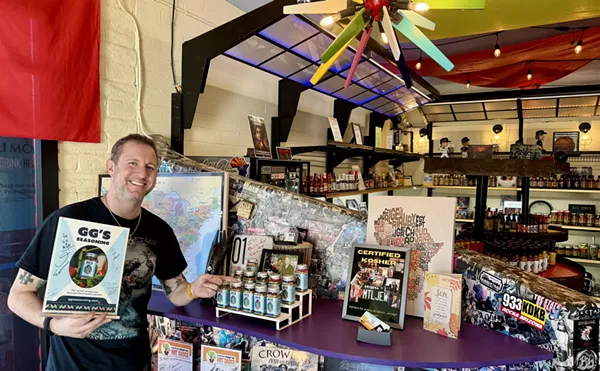Tucked inside the Tempe Farmers Market building in downtown Tempe, a hidden restaurant quietly churns out bold, soulful flavors from Puebla, Mexico, served with a side of genuine warmth.
Restaurant Huauchinango shares its colorful space with a handful of small businesses and a speakeasy. The venue is a visual feast, overflowing with kitschy charm and unexpected details. A lifelike German shepherd toy peers down from the rafters, a purple-and-gold mariachi hat hangs on the wall and empty coffee bean sacks are piled near the entrance. A hand-written, arrow-shaped sign points the way to the eatery, guiding guests beneath a ceiling of exposed ductwork, metallic-silver insulation and a patchwork of raw beams.
Restaurant Huauchinango shares its colorful space with a handful of small businesses and a speakeasy. The venue is a visual feast, overflowing with kitschy charm and unexpected details. A lifelike German shepherd toy peers down from the rafters, a purple-and-gold mariachi hat hangs on the wall and empty coffee bean sacks are piled near the entrance. A hand-written, arrow-shaped sign points the way to the eatery, guiding guests beneath a ceiling of exposed ductwork, metallic-silver insulation and a patchwork of raw beams.
Once you reach the area where the exposed ceiling gives way to corrugated tin — a gritty, industrial touch that nods to the humble homes of Puebla — you’ve arrived. It’s a subtle tribute from owner Alex Bonilla, who lived in the Mexican state before immigrating to the U.S. in the early 2000s.
The kitchen and dining area are loosely divided by two oversized jugs of agua fresca, and once guests are seated, it’s hard to discern where the restaurant ends and the marketplace begins.
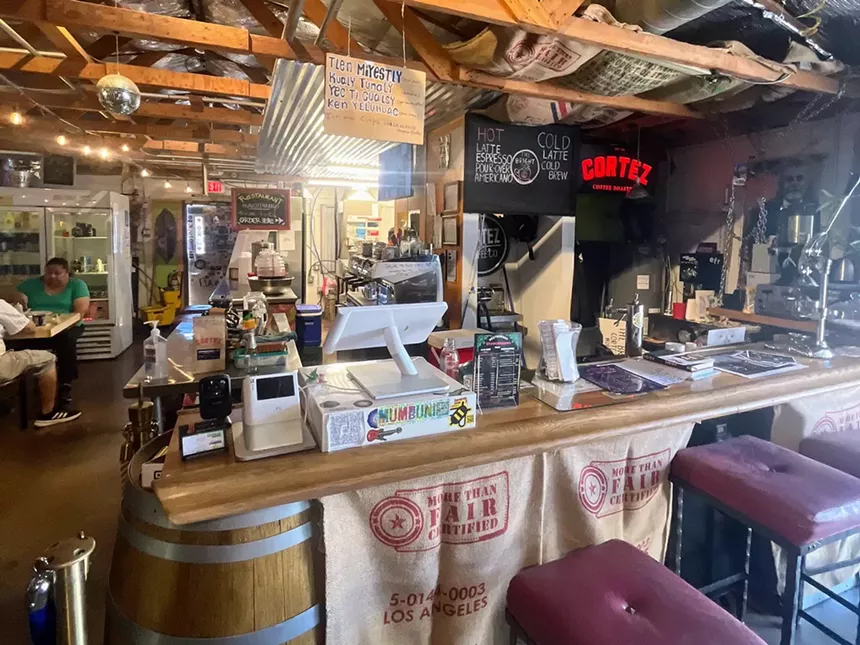
The shared Tempe Farmers Market venue is a feast for the eyes, overflowing with kitschy charm and unexpected details.
Mike Madriaga
I asked him what he would eat back home, in the rugged mountainous region of his hometown, more than 1,500 miles away.
“Try our mole,” he says, smiling. “My grandmother used to make that for me. And we also make tlacoyos, which are very traditional where I’m from.”
Before my order even goes in, I’m already sold, smitten by the hospitality. It’s the lunch rush, nearly every table is full, and Bonilla appears to be running the entire floor himself. Yet he greets every customer with the same warmth he offers me. I’m not anyone special. But at that moment, I felt like I was.
“No wonder this place — whose name I initially struggled to pronounce — has racked up 4.9- and five-star reviews online,” I mutter. And if you’re wondering what Huauchinango means, it’s the name of the city in Puebla where Bonilla lived.
While I wait, I leave my drink, menu and napkins scattered across the table to hold my spot, and then wander.
Overhead, a baby-blue mannequin lies in repose while a nearby mirror ball spins slowly, casting glimmers of light across the eclectic space. The market is packed with trinkets, collectibles, exotic snacks and rows of fiery hot sauces, some of which are tucked into a tall, gothic-style cabinet. The vibe is artsy and offbeat, perfect for a spontaneous bite or an unconventional date night.
Just past Huauchinango, beyond The Bright Side coffee and tea stand and through a casual dining nook, lies The Dark Side, a vintage-inspired bar with mid-century furniture, a chess board on top of a marble table, a folding counter, wrought iron barstools, latex Halloween masks and moody lighting. The creative drinks served to other patrons look tempting, but I resist, wanting to experience Bonilla's food with clear senses.
There’s a great mix of diners, including corporate suits, construction workers, ASU students and one curious Phoenix New Times writer. The menu is as affordable as the restaurants ending in "–bertos" with burritos for $11, tacos for $3 and four tlacoyos for $13. I order the latter, along with two other dishes.
“Your food’s ready,” Bonilla calls out.
When I return, two large platters are already waiting and a third is on the way.
“My grandma taught me how to make mole — everything really — but especially mole,” Bonilla says, setting the scene like a proud grandson. “Puebla is known for mole poblano. We use all fresh ingredients, not the store-bought stuff.”
He leans in slightly as if sharing a secret.
“Some places buy the powdered kind, but we make ours with different kinds of chiles, and the rest is a family secret, but that’s what makes people want to try it,” he says.
He serves four Enmoladas, a $15 platter of chicken enchiladas doused in the family mole. As I take the first bite of what diners may know as Enchiladas de Mole, I can taste every mile of Bonilla's journey from Puebla to Tempe.
The pieces are swaddled in a deep, satin-smooth mole that resembles dark chocolate but tastes like history. It's layered, smoky, with a smidgen of sweetness and just enough heat to make you pause and wonder. Each bite balances the earthiness of roasted chiles and nuts with the warmth of bittersweet cocoa. The chicken inside is fall-apart tender and infused with flavor, as if it’s been simmering in stories passed down through generations.
Bonilla and his wife, Flor Bonilla, prepare the mole sauce themselves. It tastes like something he's been perfecting since childhood, even though, he tells me, that wasn’t the case.
“When I lived in Mexico, I wasn’t into the restaurant business,” he admits. “But when I moved here, I changed my mind.”
Our conversation was starting to get good, then he says with a grin, “Eat your food, it’ll get cold.” Then he’s off again, helping other customers — his quiet hospitality gently convincing each one to return.
In 2004, Bonilla and his brother opened their first Puebla-inspired restaurant in Scottsdale, followed shortly by another in Phoenix.
The Phoenix location shut down after about a year and a half. Then in 2011, Bonilla launched their Mesa location with the same name as the restaurant he runs today.
“We eventually closed the Scottsdale one,” he says, “and stayed in Mesa until last year, when a fire at a neighboring business affected ours too. So, we had to fix that place and hopefully we can open it back up in a couple of months.”
The Phoenix location shut down after about a year and a half. Then in 2011, Bonilla launched their Mesa location with the same name as the restaurant he runs today.
“We eventually closed the Scottsdale one,” he says, “and stayed in Mesa until last year, when a fire at a neighboring business affected ours too. So, we had to fix that place and hopefully we can open it back up in a couple of months.”
Our conversation was starting to get good, then he says with a grin, “Eat your food, it’ll get cold.” Then he’s off again, helping other customers — his quiet hospitality gently convincing each one to return.
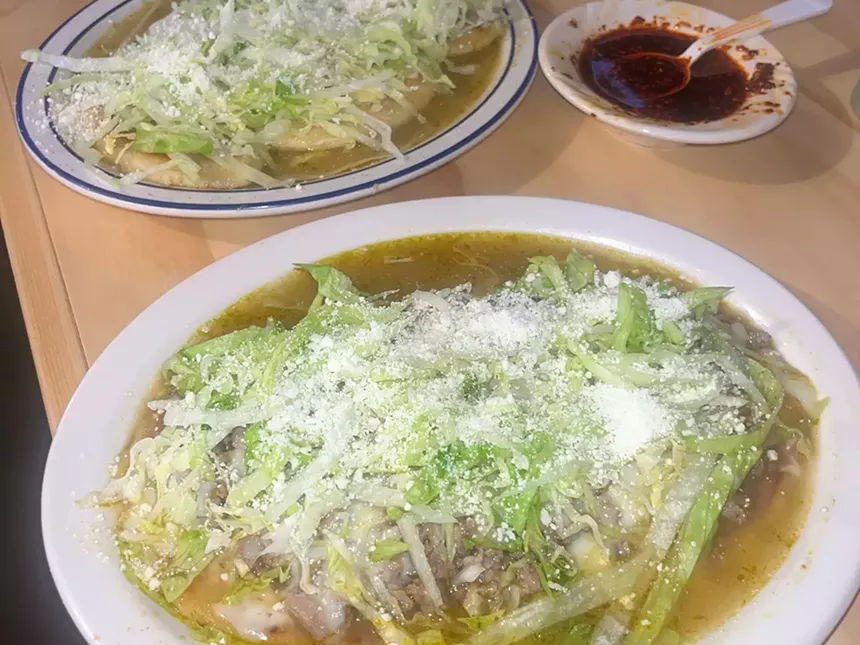
I tried the $14 huarache with carne asada and melted Oaxaca cheese and the Tlacoyos, a dish rare in the Valley but beloved where Bonilla is from in Puebla.
Mike Madriaga
"On the tlacoyos, if you want, you can add whatever meat you like (carne asada, chicken, pastor) for extra or keep it vegetarian-friendly," Bonilla says. "Many people from northern Mexico don’t always recognize these, even though they’re Mexican too."
He rushes off to help another customer and then returns to the table.
“We’ve been here for almost eight months now, and the response from people has been great,” he says. “We’re in a bar and coffee shop space, but we run the restaurant part separately. Now we all work together.”
The communal eatery-meets-self-serve shopping experience is very different from the larger-menu spot in Mesa. For drinks, you can grab bottled Mexican sodas from the fridge like Boing!, Jarritos, Fresca, or go the local route.
“We have homemade drinks,” he adds, “horchata, jamaica, strawberry lemonade, cucumber with lemon.”
Like his mom and abuelita before him, Bonilla and his crew make all the fresh drinks, tortillas and salsas in-house.
“That small dish has fried chiltepin,” he says. “Try it.”
I dip my pinky finger in and touch it to my tongue. “Bro, that’s spicy!” I blurt out. He laughs, then adds, “And we have habanero salsa, red sauce and avocado salsa.”
As I take my final bites of the third dish — a huarache ($14) with carne asada and melted Oaxaca cheese, bathed in green tomatillo sauce and topped with shredded lettuce — the dining room starts to clear out. Bonilla brings over some to-go boxes, needed thanks to the generous portions, and then offers one last suggestion.
“We’ve been here for almost eight months now, and the response from people has been great,” he says. “We’re in a bar and coffee shop space, but we run the restaurant part separately. Now we all work together.”
The communal eatery-meets-self-serve shopping experience is very different from the larger-menu spot in Mesa. For drinks, you can grab bottled Mexican sodas from the fridge like Boing!, Jarritos, Fresca, or go the local route.
“We have homemade drinks,” he adds, “horchata, jamaica, strawberry lemonade, cucumber with lemon.”
Like his mom and abuelita before him, Bonilla and his crew make all the fresh drinks, tortillas and salsas in-house.
“That small dish has fried chiltepin,” he says. “Try it.”
I dip my pinky finger in and touch it to my tongue. “Bro, that’s spicy!” I blurt out. He laughs, then adds, “And we have habanero salsa, red sauce and avocado salsa.”
As I take my final bites of the third dish — a huarache ($14) with carne asada and melted Oaxaca cheese, bathed in green tomatillo sauce and topped with shredded lettuce — the dining room starts to clear out. Bonilla brings over some to-go boxes, needed thanks to the generous portions, and then offers one last suggestion.
“We have café de olla, a traditional Mexican coffee. Would you like some?” he asks.
Without hesitation, I nod, smiling through my chewing. He returns with a filled to-go cup and sits down beside me.
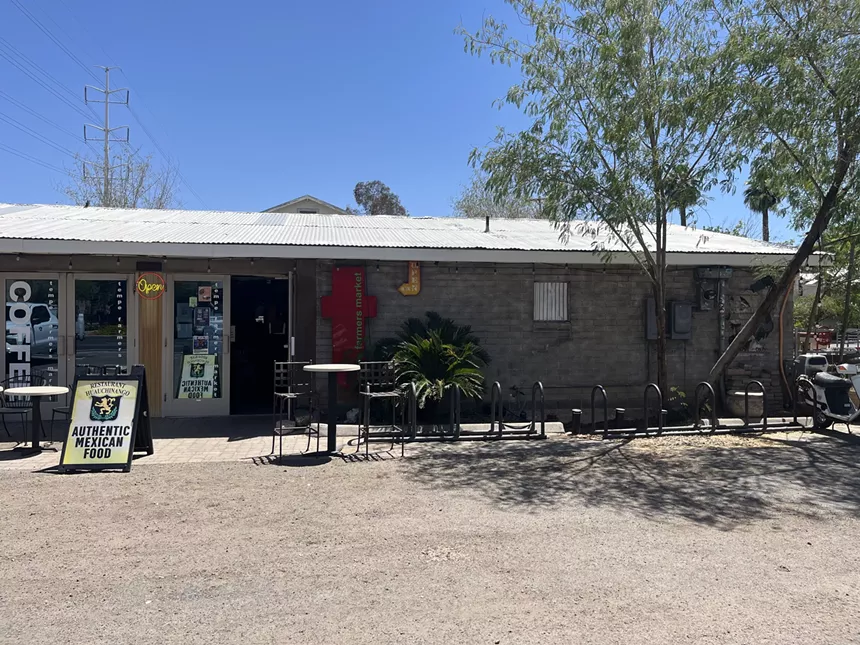
While the Mesa location is temporarily closed, customers can find Restaurant Huauchinango inside the Tempe Farmers Market.
Mike Madriaga
The coffee is slightly sweet and spiced, kissed with a hint of cinnamon and caramelized sugar.
I ask about his plans for the future, and whether he’ll return to Mesa or continue serving up dishes in Tempe.
“I like it here,” he says, nodding. “Tempe has really nice people. I’m focusing more here now, even though I still have the business in Mesa.”
The Tempe community seems to be embracing this new spot with open arms.
“The name Huauchinango doesn't just cater to people from south Mexico,” he says. "It is for everyone here in metro Phoenix.”
And that’s when it hits me: Huauchinango isn’t just a restaurant. It’s a living memory of home, a love letter from Puebla folded into fresh corn tortillas, simmered in mole and shared with strangers who leave feeling like family.
Restaurant Huauchinango
805 S. Farmer Ave., Tempe(Temporarily closed) 1620 W. University Drive, #5, Mesa

